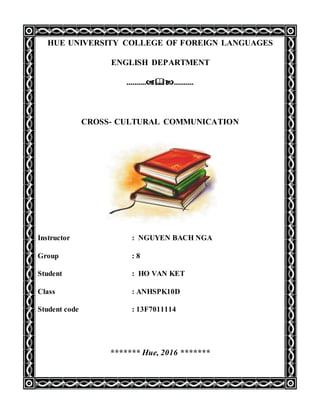
Misunderstanding in communication
- 1. HUE UNIVERSITY COLLEGE OF FOREIGN LANGUAGES ENGLISH DEPARTMENT .................... CROSS- CULTURAL COMMUNICATION Instructor : NGUYEN BACH NGA Group : 8 Student : HO VAN KET Class : ANHSPK10D Student code : 13F7011114 ******* Hue, 2016 *******
- 2. TOPIC FOR END-OF-COURSE ASSIGNMENT CROSS-CULTURAL COMMUNICATION When people from different cultures communicate, misunderstandings can happen. What are the possible reasons for those misunderstandings and what should people do in order to avoid them and prevent them from turning into cultural conflicts? Please limit your answer to no more than 1200 words.
- 3. Misunderstanding is a communication phenomenon that we often experience in our life. Especially, when we communicate with people from different cultures, the misunderstanding is inevitable. In reality, there are many possible reasons for these cases. But in my opinion, the main reasons are owing to language differences, communication styles and non-verbal misinterpretation. The important thing here is what will we have to do in order to avoid misunderstanding, does not let it results in cultural conflicts. The first reason of misunderstanding is language differences. Different languages may lead misunderstand happened as they are using their own languages to express their ideas. The fact is that in the world, there many countries and many different languages. So when two persons that use their two own languages to communicate, the communication will not be effective, even it leads to misapprehending what the speaker’s intended meaning. Forexample, a Canadian goes to visit a Cotu ethnic minority group in Thua Thien Hue, Vietnam. When he greeted "How do you do". People in the village heard this, they were very angry with him. Because of 'how' in Cotu's language means way to do something and 'do' by their understanding way is an obsceneword of Vietnamese. Cotupeople often speak Vietnamese without accent when they borrowed Vietnamese words into their language. Therefore, they believe that “How do you do” is a naughty sentence. For the listener, translation is a reasonable way of communicating in those cases. A
- 4. another clear solution to the reason is that we have to learn foreign languages such as English. Both of ways will help us in cross-cultural communication very much. Additionally, the listener also learns the way of listening, when we do not understand what the speaker said, we need to listen to interpretation from them, avoid hasty judgment. The second is different communication styles. One aspectof communication style is language usage. Across cultures, some words and phrases are used in different ways. Even simple words like “yes” and “no”can also cause misunderstandings. For example, in countries that share the English language, “yes” can vary from “maybe I’ll consider it” to “definitely yes” with many shades in between[1]. Misunderstanding happens not only between people of different cultural backgrounds, but between people of the same cultural background as well. If the cultural conventions of the speaker are widely different, misinterpretations and misunderstandings can easily arise, even result in total breakdown of communication (Richards, 1985)[2]. Another example, after the end of the holiday abroad, daughter came back home, her mother opened the doorand said "home sweet home" cheerfully. Daughter surprised, asked her "are there much candy in our home, mom?". Clearly, even if conversational partners speak the same language fluently, they also encounter communication obstacles. The first way to deal this problem is that you need to interpret accurately, clearly and slowly for
- 5. listeners. You should not use slang, idioms or ambiguous utterances too much. Try to put yourself in the other person's shoes. Especially when another person's perception or ideas are very different from your own, you might need to operate at the edge of your own comfort zone. Besides, discussing the differences in connotations and adjusting to the other’s communication style will be useful to get to know each other well[3]. The third and final reason is non-verbal misinterpretation. Although language is the most obvious barrier in intercultural encounters, non-verbal communication is also known to vary misunderstandings and cultural conflicts. Non-verbal communication expresses meaning or feeling without words. They refer to bodylanguage, gestures, touch, and facial expression and so on. The gestures, symbols or bodypositioning for these phrases often differs across cultures. For instance, in America and some of Europe, the thumbs up sign means that something is good. Meanwhile in Australia, Iran this sign is considered rude, Nigeria’s very offensive. Another symbolis the "fig", in Turkish, Greek or Dutch culture is a commonly obscene, but this symbolof good luck in Brazilian culture. These problems could be solved by learning about the meaning of non-verbal signals, you should absorb correctly its meanings in each particular country . You should not stereotypically think that all non-verbal communication styles are the same everywhere. What is more, sharing your cultural norms and learning about
- 6. those of the sojourner will help you better understand and copewith different nonverbal styles[4]. To sum up, we know that misunderstanding can happen when we communicate with people from different cultures, so our choice is remedy these misunderstanding. As I previously mentioned, we will have solutions for each reason. In addition, when trying to communicate across cultures, put aside personal feelings and listen deeply. Also, we need be open-mined in receiving something new and respect other culture countries, so as to avoid or prevent misunderstanding turn into cultural conflicts.
- 7. References [1] Smith, Miller, Archer & Hague. Issues that cause conflict (2002). [Online]. Available: http://etraining.communitydoor.org.au/mod/page/view.php? [2] Milena Miladinovic. Overcoming Obstacles in Intercultural Communication (2014). [Online]. Available: http://www.afs.org/blog/icl/?p=4881. [3] Marcelle E. DuPraw, Marya Axner. Working on Common Cross-cultural Communication Challenges (1996). [Online]. Available: www.pbs.org/ampu /crosscult.html#CONFLICT. [4] Richards, J.C. (2005). Interchange2 (3rd ed). New York: Cambridge UP.
